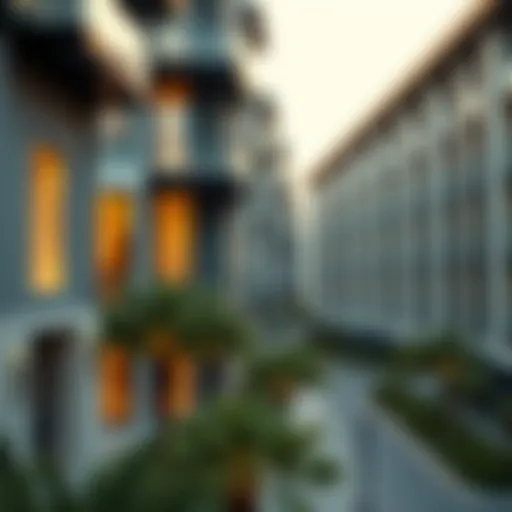Cost Analysis of Constructing Burj Khalifa
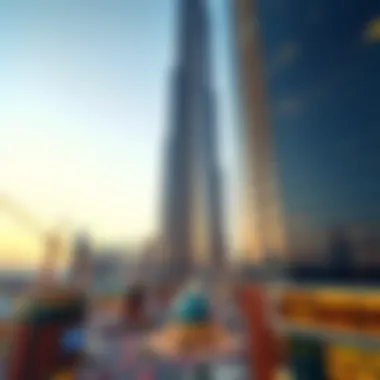
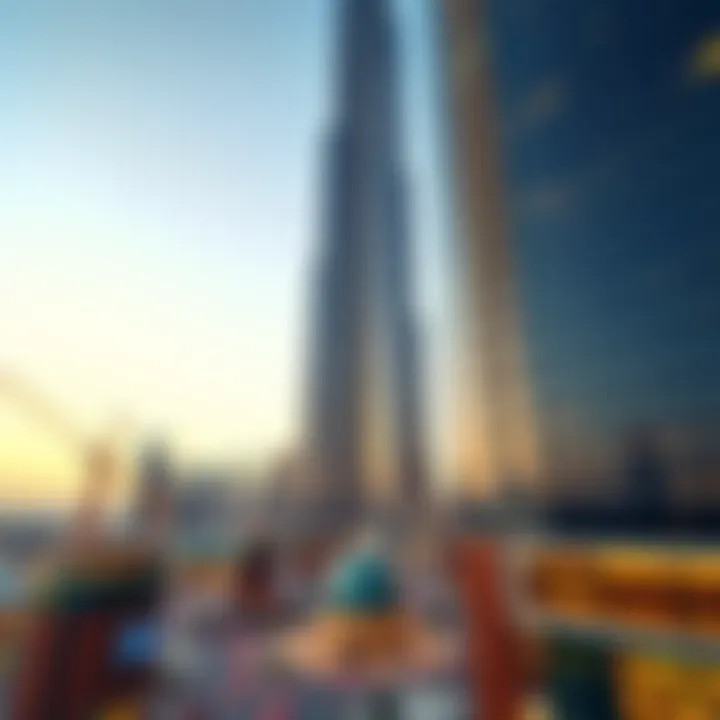
Intro
The Burj Khalifa stands as a towering symbol of ambition and innovation. Its construction wasn't merely a feat of engineering; it represented a complex interplay of finances, resources, and a vision that pushed the boundaries of what seemed feasible. Understanding the cost behind this iconic structure requires more than just statistics; it demands a look into the intricate fabric of the real estate landscape in Dubai.
In this article, we will navigate through the various dimensions of the expenses incurred in erecting this skyscraper. From the choice of materials to labor costs, and the cutting-edge technology employed, every aspect is pivotal in piecing together the entire economic picture. This exploration serves both as a guide for potential investors and as an analytical lens for those intrigued by high-value developments.
By dissecting the fundamental aspects of the construction, we aim to illuminate the economic factors that have made the Burj Khalifa not only a landmark but also a significant player within the real estate market of Dubai.
Intro to Burj Khalifa
Understanding the Burj Khalifa isn't just about appreciating its height or architectural innovation; it's essential to grasp the financial and logistical hurdles that accompanied its construction. This iconic structure stands as a testament to modern engineering, but it is also a lesson in the complexities of cost management in high-stakes projects. In this article, we'll peel back the layers of expense surrounding its development, revealing how every dollar spent contributes to its grandeur and functionality.
Overview of the Structure
The Burj Khalifa, strikingly tall at 828 meters, is the tallest building globally, redefining both Dubai's skyline and perceptions of what skyscrapers can achieve. Its architectural design, by Adrian Smith of Skidmore, Owings & Merrill, draws inspiration from Islamic architecture, mirroring the themes of desert flowers and towering minarets.
This monumental structure has 163 floors, along with an impressive array of amenities within its walls—office spaces, luxury apartments, and even a hotel operated by Armani. Each section of the skyscraper serves a specific function, all while maintaining an aesthetic that speaks to both tradition and innovation.
Moreover, the structural design required a unique blend of concrete and steel, alongside state-of-the-art materials to counter the challenges posed by Dubai's climate. The Burj's spire plays a critical role in its wind resistance while also serving as an eye-catching feature. The engineering marvel encapsulated in its design and structure reflects not only ambitious architecture but also an extensive cost framework that withstands scrutiny.
Significance in Dubai's Skyline
The Burj Khalifa has become a symbol of Dubai’s rapid growth and ambition, transforming the emirate into a hub for tourism and business. Its visual dominance in the skyline paints a picture of modern prosperity and a leap into futuristic urban living. For investors and stakeholders in real estate, the building is more than just a tall structure; it's a benchmark for architectural achievement and economic development.
The allure of the Burj Khalifa draws millions of visitors each year, boosting the economy not just through tourism but also via global investments and commercial activities. The advantages of having such an iconic landmark transcend traditional architectural achievements; they extend into tangible financial benefits for the region as a whole.
"The Burj Khalifa stands not only as the tallest building in the world but as a beacon of opportunity for investors and entrepreneurs alike."
Historical Context
The historical context surrounding the construction of the Burj Khalifa isn't merely a backdrop but a tapestry of economic, social, and cultural transformations that shaped Dubai into the global hub it is today. Analyzing this context sheds light on the decisions and strategic movements that played a fundamental role in the realization of this architectural marvel. The Burj Khalifa stands not only as a feat of engineering but also as a symbol of ambition and progress, reflecting the story of a city eager to carve its name on the world stage.
Initial Concepts and Design Phase
The conception of the Burj Khalifa was rooted in a vision to build the tallest building that not only surpassed the existing records but also set a new standard for modern architecture. The initial concepts emerged around the early 2000s when Dubai was rapidly developing. Among the ideas that floated was the necessity to create a landmark that would attract tourism and business investments. The goal was to represent the Emirate's forward-thinking approach, transformed from a modest trading post into a vibrant metropolis.
The design journey began with the Chicago-based architecture firm Skidmore, Owings & Merrill, whose lead architect, Adrian Smith, aimed to blend traditional Islamic architecture with modern building techniques. The elegance of the Burj Khalifa's design mirrors the onion domes and minarets often found in Middle Eastern architecture. The choice to accentuate vertical lines was deliberate, intended to draw the eye upward and emphasize its towering height.
However, creating such a structure came with its own set of challenges. The project demanded meticulous planning and design iterations. These concepts went through rigorous evaluations to ensure not only aesthetic brilliance but also functional integrity against the climate and structural demands.
Key Players in Construction
No monumental project can succeed in isolation; it requires a constellation of skilled professionals and firms working in concert. For Burj Khalifa, the engagement of international and local stakeholders played a significant role in bringing the vision to life. Among the key players was contractor Emaar Properties, a homegrown developer known for ambitious projects that define the skyline of Dubai. Their commitment to quality was unmatched.
The construction phase was a tapestry of collaboration. It brought together a workforce from various backgrounds, each contributing unique expertise. From structural engineers specializing in skyscraper dynamics to masons adept in local building methods, every hand was crucial in creating the Burj Khalifa.
Additionally, the project saw the involvement of various suppliers and technology partners who provided innovative materials and solutions. The choice of materials like high-strength concrete was vital, allowing the structure to reach its sky-scraping ambitions. Notably, the expertise from international consultants, such as the design consultants and engineers, ensured that global best practices were tailored to local needs.
In summary, the historical context not only narrates the tale of the Burj Khalifa but emphasizes its contributions as a beacon of hope and potential for Dubai. The seamless integration of vision, design, and skilled labor made possible a defining landmark that continues to inspire future developments worldwide.
Material Costs Breakdown
The construction of a monumental structure like Burj Khalifa demands careful consideration of how material costs impact the overall budget. Material costs don't just play a pivotal role in determining the initial investment, but they also influence long-term maintenance and operational expenses. In this section, we’ll dissect the major components of material costs, emphasizing their significance, potential benefits, and considerations that those involved in high-value developments should keep in mind.
Concrete and Steel Usage
Concrete and steel form the backbone of Burj Khalifa, giving it the strength and stability necessary to reach remarkable heights. Approximately 330,000 cubic meters of concrete were used in its construction. This sheer volume underscores not only the scale but also the financial implications. Concrete, often referred to as the most important structural element, provides both compressive strength and durability.
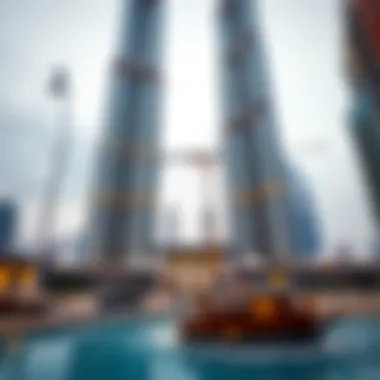
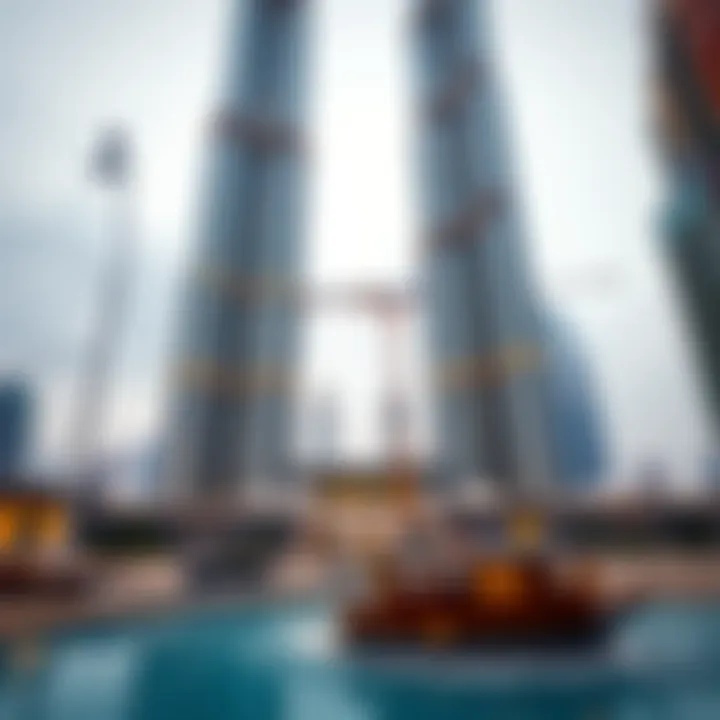
However, it's not just the amount of concrete used that matters—it’s also the kind. High-performance concrete was employed, characterized by durability and resistance to weathering and environmental degradation. While the initial cost per cubic meter may be higher than standard concrete, the long-term savings in maintenance and repair costs make this investment worthwhile.
Steel was used extensively—about 103,000 tons, to be precise—for the vertical load-bearing structure. Steel is essential for skyscrapers as it allows for flexibility and resilience against wind loads. The choice of advanced high-strength steel not only ensures safety but also optimizes the material cost by lessening the quantity needed.
"Investing in quality materials like high-performance concrete and advanced steel can save billions in repairs and operational costs over a building's life cycle."
Glass Facade and Aluminium Cladding
The exterior of Burj Khalifa is cloaked in glass and aluminum, which not only contribute to its striking aesthetic appeal but also play a significant role in thermal insulation and energy efficiency. The approximately 103,000 square meters of glass used in the facade is not your average pane; it's a specially designed, reflective glass that minimizes heat absorption while maximizing natural light.
While glass shopping may lead one to consider looks first, the high cost of this specialized glass is tempered by its energy-saving properties. This investment helps keep cooling costs down in a region known for scorching temperatures.
Meanwhile, the aluminum cladding chosen for this architectural marvel is lightweight and corrosion-resistant, which adds to the building's durability, an essential factor considering Dubai's climate. The overall design integrates both materials in a way that not only enhances the building's beauty but ensures it withstands the test of time. The combination of visually stunning glass and robust aluminum can escalate costs upfront but can lead to deeper savings in energy expenditure.
In summary, the material costs involved in constructing the Burj Khalifa are complex and multifaceted, significantly affecting both the immediate financial outlay and long-term viability of the structure. With smart investments in concrete, steel, glass, and cladding, each material serves a purpose that transcends its initial cost, proving essential for such a grand endeavor.
Relevant resources:
Labor and Workforce Expenses
In exploring the costs associated with constructing Burj Khalifa, one cannot overlook the significance of labor and workforce expenses. This aspect of the project encapsulates a wide array of considerations—from the skill level of workers involved to the effects of employing local versus foreign labor. Understanding these dimensions reveals not just the direct financial implications but also the cultural and logistical challenges that arise in such a grand engineering endeavor.
Skilled vs. Unskilled Labor
The distinction between skilled and unskilled labor is vital when assessing the financial framework of building the Burj Khalifa. Skilled labor, often comprising engineers, architects, and specialized artisans, forms the backbone of any complex construction project. These professionals typically command higher wages, reflecting their expertise and the specific knowledge they bring to the table.
In contrast, unskilled laborers—those involved in basic tasks such as material handling or general site upkeep—are paid significantly less. However, their contribution is equally essential, as no structure can rise without a solid foundation laid by hands that may not be accredited but are nonetheless indispensable.
Employing a mix of both types of labor optimizes the workforce's effectiveness. For instance, while skilled labor oversees critical stages of construction, unskilled labor can efficiently manage day-to-day tasks, ensuring the project proceeds on schedule. Although the initial investment in skilled workers might seem higher, their influence on the quality and safety of the build can lead to long-term savings by diminishing chances of structural issues down the line.
Impact of Local and Foreign Workers
When delving into the workforce dynamics of the Burj Khalifa project, a key discussion point arises from the impact of local and foreign workers. Dubai's construction industry has become a melting pot of cultures, with a significant percentage of workers hailing from different countries. This diverse workforce brings an array of skills, perspectives, and experiences.
Using local workers can be advantageous as they tend to have a better understanding of regional regulations and cultural norms, which can facilitate smoother operations on-site. However, the skill set available locally may not always meet demand for the specialized tasks needed in constructing a megastructure. Thus, many developers turn to foreign labor to fill these gaps. Employing workers from nations known for their construction expertise—such as India and Pakistan—can enhance project efficiency as these individuals often possess the necessary technical skills.
Nevertheless, relying heavily on foreign workers raises various challenges, including higher costs related to visas, living accommodations, and transportation. Moreover, it can create potential communication barriers, which might lead to misunderstandings if not carefully managed.
Considering these factors, the balance between local and foreign labor is crucial. Utilizing local talents not only supports the community but also ensures compliance with legal requirements, while foreign workers help achieve the high standards expected of a project like Burj Khalifa. Finding this equilibrium is integral to minimizing costs and maximizing the efficacy of the workforce.
In summary, the labor and workforce expenses involved in constructing Burj Khalifa illustrate the delicate balancing act needed to achieve project goals while managing costs.
Understanding these labor nuances is essential for stakeholders in the real estate and construction sectors, especially those looking to invest or develop high-value projects in Dubai and beyond.
Technological Innovations in Construction
Technological innovations have played an instrumental role in the construction of the Burj Khalifa. Not only have they enhanced efficiency, but they also significantly influenced the overall cost analysis associated with such an extensive project. Key advancements in tools and methods have redefined how construction is executed. Emphasizing speed and precision, these innovations have transformed traditional building practices into a sophisticated combination of art and science.
Use of Advanced Machinery
In the tall order of erecting a skyscraper like the Burj Khalifa, advanced machinery proved essential. The use of cranes such as the CLT 70 facilitated the delicate balance of lifting heavy materials to dizzying heights. These cranes are designed with high capacity and stability, making them a vital asset in the construction process.
Another notable machinery innovation is the use of self-climbing formwork. This technology allows the formwork to ascend with the building as it rises, reducing the need for cranes and accelerating the construction timeline. By streamlining operations, labor can be utilized more efficiently, decreasing overall costs associated with downtime and equipment rentals.
It's crucial to consider that maintaining these machines isn't cheap. Regular upkeep and skilled operators are necessary to ensure smooth operations, which raises budgetary considerations which must be factored into the overall analysis. However, the long-term benefits often outweigh these immediate costs.
"Technological advancements in construction allow for unprecedented levels of precision, which in return decrease losses and improve timelines."
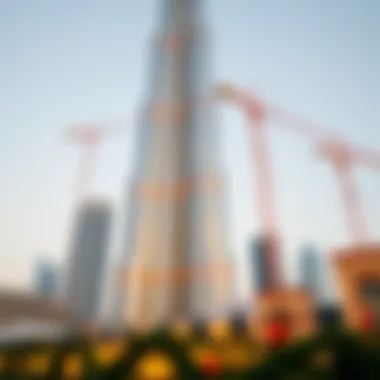
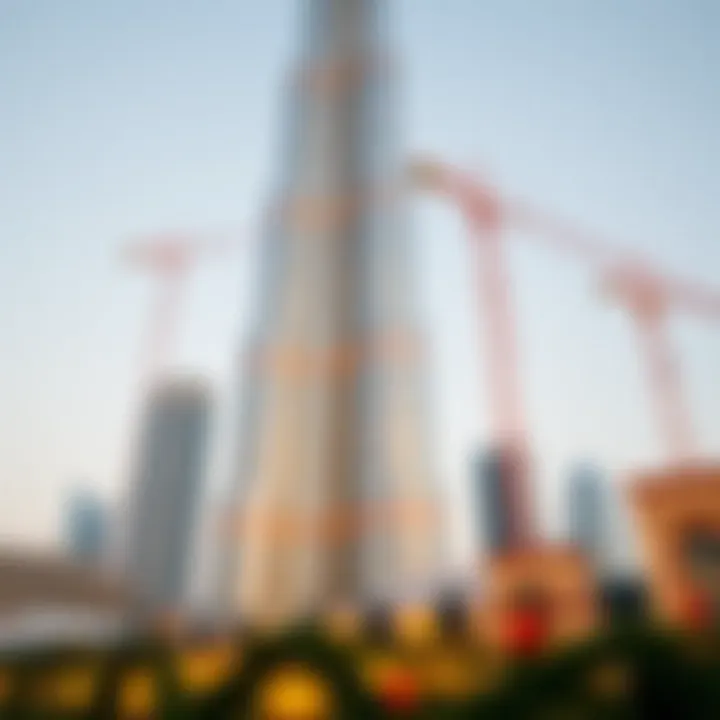
Building Information Modeling (BIM)
Another significant leap in construction technology is the implementation of Building Information Modeling (BIM). This innovative approach transforms how property stakeholders approach building design and coordination throughout the construction lifecycle. By creating a digital representation of the physical and functional characteristics of a facility, BIM enhances collaboration among architects, engineers, and contractors.
BIM fosters a visualization that aids in early clash detection - a process designed to identify conflicts in the design phase rather than during construction. This capability minimizes costly reworks and delays, invaluable when constructing a project of this magnitude. Further, reports suggest that BIM can cut costs up to 20%, simplifying the intricacies involved in large-scale projects.
It's also important to mention the role of data analytics within BIM, allowing more informed decision-making based on predictive modeling and simulations. Such insights can guide investments and operational choices, making it a worthwhile consideration for investors involved in high-stake projects.
Financing Strategies
Understanding the financing strategies behind the construction of Burj Khalifa is essential to grasp the broader financial landscape of such an ambitious project. The financing not only covers the construction costs but also highlights the economic viability and the potential return on investment which is significant for key stakeholders involved, including investors, property managers, and city planners. Recognizing the diverse funding sources and financial structures employed gives insight into how grand projects can culminate in monumental outcomes like the Burj Khalifa.
Initial Investment and Funding Sources
The initial investment for the Burj Khalifa was substantial. Reports suggest that the total cost of construction reached around $1.5 billion. This hefty sum required a well-planned financial strategy, combining multiple funding sources to achieve a successful outcome.
A major part of the investment originated from Emaar Properties, a leading real estate developer in the UAE, which took a primary role in financing the project. However, relying solely on one entity would have risked the project's financial stability, hence partnerships with local banks and international financial institutions were formed. Investors from various backgrounds, including private equity and sovereign funds, contributed additional capital to share both the risk and reward of this grand venture.
The blend of financing types included:
- Equity financing: Significant equity contributed by Emaar and other stakeholders laid the groundwork for the project.
- Debt financing: Loans from banks, including Islamic financing options, provided a critical boost, ensuring that cash flow could meet the immense demands of construction.
- Public-private partnerships: Engaging the government as a partner allowed for shared investment and broader accessibility to resources.
Ultimately, the variety of funding sources and the investor engagement model were crucial for the feasibility of Burj Khalifa’s construction.
Financial Breakdown Throughout the Project
As with any monumental structure, a financial breakdown throughout the project timeline demonstrates not only the allocation of resources but also the management of risks. The financing process of the Burj Khalifa can be examined in stages, reflecting how funds were mobilized over the course of construction.
At various stages, the focus was on adjusting to the dynamic financial landscape, expenditures varied depending upon construction phases, which typically can be marked as follows:
- Pre-construction Phase: This stage saw considerable expenses related to land acquisition and architectural design, funded by initial investments and feasibility studies. Money was spent on drawing up plans, and conducting environmental assessments, which laid a solid financial foundation.
- Construction Phase: This phase required continuous financial injections, primarily for materials and labor. The ongoing expenses were monitored and adapted as challenges emerged. Adjustments to financial strategies were necessary to manage cash flow efficiently.
- Finalization and Operational Phase: Closures are not the end, but just the transition to operational financial management. Here, funds need to shift focus to asset management, marketing, and operational costs post-construction. This involved securing leases, marketing the property, and managing ongoing operational expenses.
The careful management of these financial phases determined the ultimate success of the Burj Khalifa, enabling it not only to stand tall as an architectural marvel but to become an economically viable venture.
"Understanding financing strategies is key to unlocking the true potential of monumental architecture like the Burj Khalifa."
For more on the implications of financing in large-scale developments, check out Emaar Properties and the extensive details offered by Wikipedia.
Design and Architectural Costs
The financial aspects tied to design and architectural costs hold significant weight in any large-scale construction project, and the Burj Khalifa is no exception. This towering symbol of ambition and engineering prowess in Dubai required meticulous planning and execution from the very onset of its conception. Understanding these costs is vital as they contribute directly to both the functionality and aesthetic appeal of the final structure. With a project of this magnitude, the budget allocated for design is not merely a line item; it plays a pivotal role in establishing the project's viability and its impact on the surrounding environment and community.
Architectural Design Expenses
When it comes to the architectural design expenses of the Burj Khalifa, several key factors intertwine to form a complete picture of the overall cost. The initial phase involved extensive research and development, spearheaded by the renowned architectural firm, Skidmore, Owings & Merrill. These expenses encompass fees for architects, engineers, and consultants, who collaborated to bring the vision of Burj Khalifa to life.
- Conceptualization and Planning: The artistic vision translates the abstract into concrete through blueprints and models, which often come with hefty costs. From the sleek, modern lines that define the structure to the consideration of cultural resonance with local aesthetics, these factors require time and resources.
- Design Innovation: This skyscraper’s form, crafted to withstand high winds and seismic activity, means that costs also reflect innovative engineering solutions. Technological advances play a crucial part and may add to initial expenses but ultimately enhance the building's durability and safety.
- Materials Selection: High-quality materials are essential for the design's execution. Premium selections lead to enhanced longevity but significantly raise the total cost. For instance, the choice of specialized glass for the facade not only contributes to energy efficiency but also ensures that the skyline remains visually striking.
These elements combined create a layered cost structure where each decision can alter the project's financial trajectory. Therefore, investing in robust architectural design can save costs down the line by minimizing future repairs and ensuring regulatory compliance.
Cost of Environmental Considerations
As the global focus on sustainability and environmental concerns grows, the cost implications of these considerations cannot be overstated. For Burj Khalifa, integrating environmental sustainability into its design was not just a moral obligation but also a business decision steeped in foresight. These costs generally encompass several areas:
- Sustainable Materials: The selection of eco-friendly materials often comes at a premium. However, the long-term benefits—including lower energy usage and reduced maintenance costs—can offset these upfront expenses. Such choices may involve recycled glass or locally sourced materials that minimize the carbon footprint.
- Energy Efficiency Technologies: The implementation of energy-efficient systems, including advanced HVAC protocols and intelligent lighting, although initially expensive, promise dramatic reductions in operational costs. Investing in such technologies is a leap toward sustainability, yielding financial returns through energy savings and enhancing the building’s marketability.
- Regulatory Compliance: Exceeding local environmental regulations early on instills a sense of reliability in the project. Costs incurred here may include impact assessments and the construction of green spaces, yet they add immense value to the property in terms of community relations and investor appeal.
The Burj Khalifa project highlights how design and environmental considerations together create a holistic approach to architectural costs. Each expense is a step toward a sustainable future, proving that initial expenditures in these areas can lead to long-term gains.
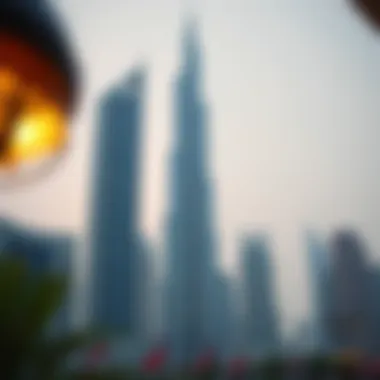
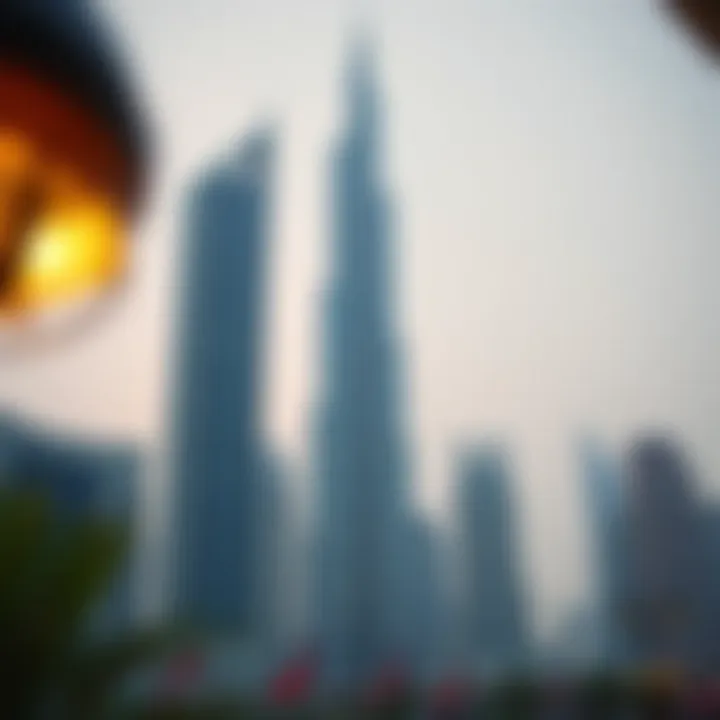
Regulatory and Compliance Costs
When embarking on a colossal project like the Burj Khalifa, it’s essential to navigate the complex landscape of regulatory and compliance costs. These costs form a significant component of the overall financial outlay required to erect a skyscraper that pierces the clouds. They not only ensure that the construction adheres to safety and environmental standards but also mitigate potential future liabilities that could arise from non-compliance.
The building of Burj Khalifa was governed by a multitude of local and international regulations. These regulations dictate everything from construction materials and design elements to safety protocols and environmental considerations. Failing to comply can lead to severe repercussions, such as fines, delays, and reputational damage, which can undermine investor confidence and profitability.
Building Codes and Standards
Building codes are essential guidelines that dictate the construction practices for safety, health, and sustainability. In Dubai, the municipality has stringent regulations that developers must adhere to, which cover various aspects such as structural integrity, fire safety, and energy efficiency.
Key components of these codes include:
- Structural Requirements: Ensures the building can withstand environmental stresses like wind and earthquakes.
- Life Safety Codes: Focus on the safety of occupants regarding fire hazards and ensuring safe exits during emergencies.
- Accessibility Standards: Compliance with regulations that make buildings accessible to all, including individuals with disabilities.
Through thorough adherence to these codes, the Burj Khalifa project not only fulfilled legal mandates but also set a benchmark for architectural excellence in the region. The input from specialized engineers and safety consultants played a pivotal role in integrating these requirements seamlessly, ensuring the structure’s ultimate safety and operability.
Impact of Other Regulatory Bodies
Apart from local building codes, other regulatory bodies also influence construction projects significantly. These entities can range from environmental agencies to international construction standards organizations. Their guidelines can impose additional costs, which are often seen as burdens but are crucial for holistic development.
- Environmental Regulations: The Burj Khalifa project had to comply with local environmental laws that govern land usage and resource conservation. Regulations related to water usage, wildlife conservation, and pollution control were thoroughly examined and incorporated.
- International Standards: Compliance with globally recognized construction standards, such as those established by the International Organization for Standardization (ISO), ensured that the project met the highest benchmarks. This not only added credibility but also facilitated investments from international stakeholders who seek assurance of quality and safety.
The collaboration with these varied regulatory bodies brought value beyond mere compliance. It fostered a culture of responsibility and accountability among the stakeholders, reinforcing the project's commitment to sustainable and safe urban development.
“The real cost of construction lies not only in the physical materials but also in the invisible framework of regulations ensuring those materials serve their intended purpose.”
Long-term Financial Impacts
Understanding the long-term financial impacts of constructing Burj Khalifa is indispensable for stakeholders in the realm of real estate and investment. It’s more than just a tall building; it embodies an intricate web of financial factors that come into play after the last beam is placed. The operational costs that emerge over time and the financial returns generated, both directly and indirectly, shape the ongoing financial landscape for owners and investors.
Operational Costs Over Time
Once the construction dust settles, the reality of maintaining such a colossal structure sets in. Operational costs cover everything from utility bills to routine maintenance. Given the Burj Khalifa's grandeur, these expenses are not just routine but monumental.
- Utilities: Water, electricity, and air conditioning are substantial. The building’s height means additional expenses in terms of energy consumption needed to transport water to the upper floors.
- Routine Maintenance: Regular checks of the facade, elevators, and HVAC systems require skilled personnel and innovative technology, contributing to long-term financial obligations.
- Insurance Costs: High-value properties like Burj Khalifa attract higher insurance premiums, which must be budgeted for annually.
Addressing these costs isn’t merely a matter of sums and figures but strategic planning to ensure the building not only stands tall but operates efficiently for years to come.
Financial Returns and Profitability
The return on investment from Burj Khalifa extends beyond the immediate financial influx during its construction. The skyscraper continues to generate revenue streams that influence various sectors.
- Rental Income: Leasing office spaces and luxurious residences consistently creates a steady cash flow. The demand for premium real estate in such a landmark is typically robust.
- Tourism Revenue: With millions visiting each year for the breathtaking views from the observation level, the Burj Khalifa acts as a key driver of tourism in Dubai, translating into revenue for both the building and the surrounding economy.
- Branding and Prestige: Owning or investing in such a distinctive asset elevates business profiles, often leading to increased patronage in local establishments and higher property prices in the vicinity.
“The Burj Khalifa is more than a building; it’s a symbol of prosperity and progress that continues to attract not just visitors but substantial financial opportunities.”
In summary, the financial aspects related to the Burj Khalifa's longevity are complex yet pivotal. Properly accounting for operational costs alongside the anticipated financial returns underlines the importance of diligent financial planning and strategies for those involved in high-value developments.
The End
The conclusion serves as a crucial segment of our exploration into the cost analysis associated with the construction of the Burj Khalifa. It allows the opportunity to reflect on the multifaceted costs involved, ranging from materials and labor expenses to technological innovations and financing strategies. Each of these elements combines to form a detailed financial tapestry that showcases the complexity of such monumental architecture.
Summary of Key Points
In summary, we have dissected several integral aspects:
- Material Costs: The extensive breakdown of concrete, steel, glass, and aluminum used fundamentally shaped the overall expenses.
- Labor Dynamics: Differentiating between skilled and unskilled labor, along with the implications of employing local versus foreign workers.
- Technological Innovations: How advanced machinery and Building Information Modeling (BIM) have revolutionized construction techniques, ultimately affecting costs.
- Financing Strategies: A thorough analysis of funding sources and financial breakdown over the project's lifespan.
- Design and Compliance Costs: Fundamental costs related to architectural design and adherence to regulatory standards that shaped construction strategies.
- Long-term Financial Outlook: Assessing operational costs, anticipated profit margins, and the overall financial sustainability of maintaining an iconic structure like this.
Through these key points, it becomes evident how interconnected each facet is to the other, creating a comprehensive picture of financial realities that developers must navigate.
Implications for Future Developments
The insights gained from analyzing the construction costs of the Burj Khalifa have significant implications for future developments in similar high-value areas. Understanding the intricate balance of material quality, labor availability, and regulatory requirements paves the way for more effective planning and resource allocation in forthcoming projects.
- Sustainability: As investors allocate resources in iconic architecture, a focus on sustainable practices can yield long-term benefits. Prioritizing environmentally-friendly materials and engaging with local labor may enhance overall project resiliency while simultaneously reducing ongoing operational expenses.
- Adoption of Advanced Technologies: The move towards utilizing advanced technologies can optimize efficiency across various sectors of construction. A commitment to continuous innovation is vital as it may minimize costs through streamlined processes.
- Economic Impact: Future developments should also consider the broader economic context of the region. The rise of new projects can stimulate local economies, but they must be approached with careful evaluation to ensure balanced growth without oversaturation of the market.

